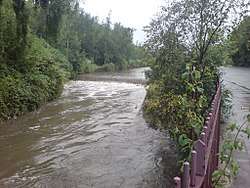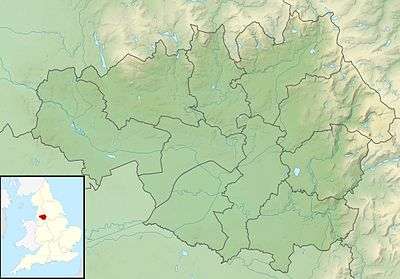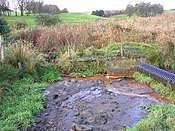River Irk
The River Irk is a river in North West England that flows through the northern suburbs and towns of Greater Manchester.
| River Irk | |
|---|---|
 | |
 Location of the mouth within Greater Manchester | |
| Location | |
| Country | England |
| Physical characteristics | |
| Source | |
| • location | Royton |
| Mouth | |
• location | River Irwell |
• coordinates | 53°29′12.93″N 2°14′42.13″W |
It rises to the east of Royton and runs west past Chadderton, Middleton and Blackley before merging with the River Irwell in Manchester city centre.
History
Historically, the Irk was also known as Iwrck or the Irke, names thought to have been derived from the Roebuck, suggesting that at one time it was a swift-running river.[1]
In medieval times, there was a mill by the Irk at which the tenants of the manor ground their corn and its fisheries were controlled by the lord of the manor. In the 16th century, throwing carrion and other offensive matter into the Irk was forbidden. Water for Manchester was drawn from the river before the Industrial Revolution.[2] A bridge over the Irk was recorded in 1381. The river was noted for destructive floods. In 1480, the burgesses of Manchester described the highway between Manchester and Collyhurst which "the water of Irk had worn out". In 1816, of seven bridges over the Irk, six were liable to be flooded after heavy rain but the seventh, the Ducie Bridge completed in 1814 was above flood levels.[3]
According to The New Gazetteer of Lancashire (1830) the Irk had "more mill seats upon it than any other stream of its length in the Kingdom" and "the eels in this river were formerly remarkable for their fatness, which was attributed to the grease and oils expressed by the mills from the woollen cloths and mixed with the waters."[4] However, by the start of the 20th century the Irk Valley between Crumpsall and Blackley had been left a neglected river, "not only the blackest but the most sluggish of all rivers".
Friedrich Engels described the banks of the Irk in Manchester at the height of the city's industrial excess.[5]
The river has since been culverted as it reaches the city centre. It disappears beneath Manchester Victoria railway station into a brick tunnel at Ducie Bridge and empties into the Irwell beneath a railway viaduct.
On 15 August 1953, the front coach of a Manchester to Bury electric train fell from the viaduct over the River Irk after colliding with a local steam train. Ten people were killed and 58 injured in what became known as the Irk Valley Junction disaster.[6]
Tributaries

- Moston Brook (later Moss Brook)
- Boggart Hole Brook
- Heaton Brook
- Boardman Brook
- Wince Brook
- Springs Brook
- Whit Brook
- Trub Brook
- Tandle Hill Brook
- Thorp Brook
- Luzley Brook
- Long Brook
References
- "History of the valley". The Irk Valley Project. Archived from the original on 2007-12-17. Retrieved 2007-12-12.
- Farrer, William; Brownbill, J., eds. (1911), "Townships: Manchester (part 2 of 2)", A History of the County of Lancaster: Volume 4, British History Online, pp. 230–251, retrieved 12 August 2012
- Farrer, William; Brownbill, J., eds. (1911), "The city and parish of Manchester: Introduction", A History of the County of Lancaster: Volume 4, British History Online, pp. 174–187, retrieved 12 August 2012
- Clarke, Steven Reynolds (1830). The New Lancashire Gazetteer. Holborn: Henry Teesdale and Co. p. 72.
- Friedrich Engels, The Condition of the Working Class in England, quote: "The south bank of the Irk is here very steep and between fifteen and thirty feet high. On this declivitous hillside there are planted three rows of houses, of which the lowest rise directly out of the river, while the front walls of the highest stand on the crest of the hill in Long Millgate. Among them are mills on the river, in short, the method of construction is as crowded and disorderly here as in the lower part of Long Millgate. Right and left a multitude of covered passages lead from the main street into numerous courts, and he who turns in thither gets into a filth and disgusting grime, the equal of which is not to be found - especially in the courts which lead down to the Irk, and which contain unqualifiedly the most horrible dwellings which I have yet beheld. In one of these courts there stands directly at the entrance, at the end of the covered passage, a privy without a door, so dirty that the inhabitants can pass into and out of the court only by passing through foul pools of stagnant urine and excrement. This is the first court on the Irk above Ducie Bridge - in case any one should care to look into it. Below it on the river there are several tanneries which fill the whole neighbourhood with the stench of animal putrefaction. Below Ducie Bridge the only entrance to most of the houses is by means of narrow, dirty stairs and over heaps of refuse and filth. The first court below Ducie Bridge, known as Allen's Court, was in such a state at the time of the cholera that the sanitary police ordered it evacuated, swept and disinfected with chloride of lime. Dr. Kay gives a terrible description of the state of this court at that time. Since then, it seems to have been partially torn away and rebuilt; at least looking down from Ducie Bridge, the passer-by sees several ruined walls and heaps of debris with some newer houses. The view from this bridge, mercifully concealed from mortals of small stature by a parapet as high as a man, is characteristic for the whole district. At the bottom flows, or rather stagnates, the Irk, a narrow, coal-black, foul-smelling stream, full of debris and refuse, which it deposits on the shallower right bank."
- "Irk Valley Junction 1953". Danger Ahead! – Historic Railway Disasters. Retrieved 2007-12-12.
External links
| Next confluence upstream | River Irwell | Next confluence downstream |
| River Croal (West) | River Irk | River Medlock (East) |